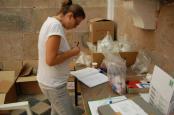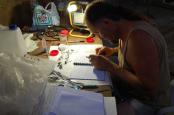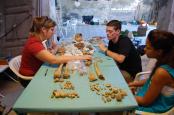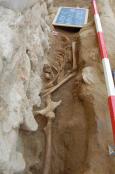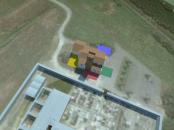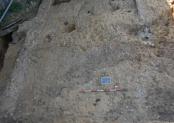CAMPAGNA 2012 |
1° SETTIMANA |
2° SETTIMANA |
3° SETTIMANA |
4° SETTIMANA |
5° SETTIMANA |
6° SETTIMANA |
12 LUGLIO 2012 
Resoconto della giornata di scavo
Area 1000
Dopo la rimozione degli strati superficiali nella porzione ampliata, � stata ulteriormente messa in luce la situazione stratigrafica della parte nord-orientale dell�area di scavo. Inoltre � stata messa in evidenza la risega del transetto nord della chiesa nella zona nord-ovest dell�area. Continua poi lo scavo della trincea realizzata per la messa in opera della canaletta di drenaggio di fine et� moderna che ci ha permesso di notare un cambiamento nella sua direzione.
Upon the removal of the topsoil in the expanded excavation area, we highlighted the stratigraphy of the north-eastern portion of the area. Additionally, we exposed the foundation of the north transect of the church, as well as of the modern-era drainage ditch previously identified. This allowed us to detect a change in the direction of the ditch, which will be further explored in the future.� �
Area 2000
Il Settore B continua ad essere caratterizzato da livelli di cantiere ancora riconducibili alla met� dell�Ottocento; sono state infatti individuate e documentate due ulteriori buche circolari (UUSS -2214 e 2217) nella porzione centrale del settore, allineate tra loro. La rimozione del riempimento del taglio (US -2206) lungo il perimetro del campanile, ha permesso di individuare sul fondo la probabile risega del campanile, databile quindi al XII secolo. Oltre a questa, sembra emergere presso l�angolo sud orientale un�ulteriore struttura che prosegue al di sotto del taglio stesso in direzione Nord. Le relazioni stratigrafiche ed i loro andamenti saranno definiti nei prossimi giorni. Nel Settore A prosegue l�indagine delle fasi cimiteriali riferibili al periodo settecentesco e ottocentesco. E� stata messa in luce una sepoltura il cui individuo (Us 2093), orientato WE, risulta essere tagliato longitudinalmente dalla risega dell�edificio del 1862; di questo si conservano l�emitorace, l�arto superiore leggermente flesso, parte del bacino ed il femore sinistro.
Today began day three of digging. �Alexa was taken from our site to work with the GIS software and the total station machine to document the new finds from the badia for today. �This included several excavations at our site. �Adam and Walker began the day by continuing to clear fill from cut US-2206, as well as continuing to clean cuts 2209 and 2211. �US-2206 west yielded what may possibly be part of the original foundation of the belfry. �The east portion of this cut yielded many very large rocks that have not been fully excavated. �We believe there may be more under the main layer of sector B of our area to the north and that they could be left over from the construction of one of the other church buildings. �Our site instructor Silvia, uncovered cut US-2214 while Molly uncovered cut US-2216. �It is probable that these cuts were made to accommodate some type of scaffolding used in the construction of the newest part of the church. �We can infer this because they were in line with each other as well as several cuts that were discovered in sector A in the 2011 season, and all the cuts seem to be generally round in shape. �Veronica continued excavating the same skeleton she had been working on previously, which we now know to be US-2193. �This skeleton is located along the southern edge of sector A. �Besides the right half of the skeleton that was destroyed by the construction of the 1862 expansion of the church, the skeleton was also missing the cranium and the lower left leg. �The skeleton is in fair to good condition, with several elements �still articulated. �Hopefully this specimen will be fully excavated by tomorrow! �Claire continued to excavate the skeleton in the North-West corner of sector A, US-2102. �This skeleton is highly fragmented. �The pelvis was fractured post-mortem, along with many of the other skeletal elements. �The vertebral column was removed in one large section. �Another nail was discovered near the pelvis that is possibly from the entombment of the remains. � The lower half of the body is still un-excavated outside of the excavated portion of area 2000. �We hope to make more progress on our site in the coming days.
Area 3000
L�area 3000 si allarga! Nel corso della mattinata i mezzi meccanici hanno portato a termine l�ampliamento della superficie di scavo verso ovest, raggiungendo complessivamente un�estensione di 66 mq. Durante i lavori di escavazione la pulizia del Settore B ( a sud del muro US 3073) ha permesso di evidenziare i limiti di una fossa sepolcrale, US � 3156, orientata N-S e collocata lungo il limite S-E dell�area, lungo il muro della facciata della chiesa. All�interno della tomba � deposto, in decubito dorsale, l�individuo US 3170, orientato N-S, di cui � stato possibile mettere in luce solamente la porzione destra del corpo, poich� il lato sinistro � stato investito dalla ricostruzione della facciata della chiesa, anteriore alla sepoltura suddetta, che continua al di sotto dell�edificio religioso. Dello scheletro si conservano il cinto scapolare destro, ben preservato, alcune coste dell�emitorace destro, l�omero, l�avambraccio e la mano; degli arti inferiori rimangono solamente la patella, la fibula, il piede e la tibia, che � stata rimaneggiata e ruotata di 180�. La decomposizione del corpo � avvenuta parzialmente in spazio vuoto, forse all�interno di una cassa lignea, come sembra suggerire il ritrovamento di un numero cospicuo di chiodi disposti� in modo regolare lungo il margine inferiore del taglio della fossa. Mentre le ossa degli arti inferiori risultano disconnesse, quelle della porzione superiore del corpo sono in connessione anatomica. La sepoltura risulta inoltre intercettata e tagliata da una buca ( US -3156) nella porzione centrale, che ha asportato parte dell�emitorace destro, del bacino e del femore. Di fianco alla tibia sono state messe in luce anche alcune ossa ( scapola, vertebra ed un osso lungo) appartenenti ad un individuo perinatale, la cui relazione con l�individuo adulto US 3170 deve ancora essere chiarita.
Today we started with the extension of our site
two meters to the west with a back hoe. We split up into two groups; half
worked on cleaning the extension. The other two dug the top half of a burial,
during which they found a small religious pendant from a rosary next to a
juvenile skull. After this Emma, Amelia, and Michael worked to uncover the
Northwest end corner until a burial was discovered and covered for excavation
at a later time. Heather, Frank, and
Emma worked to excavate a burial, which was cut by a hole in the middle, which
caused the pelvis and femur to be missing. Furthermore, half of the skeleton is
buried underneath the wall of the church because it is older than the wall. It
is believed to be the same burial because it is on the same level, is
represented by only the right side of the body, and four nails were found,
indicating a coffin burial. The tibia had been moved as evident by its being
flipped to the right. We exposed the ribs, clavicle, scapula, humerus, radius,
tibia, fibula, and a pile of metacarpals and metatarsals.
Michael and Amelia worked on what appears to be multiple bodies in a lytic tomb
in the Southeast sector of the site. The remains of these individuals were
uncovered and, currently, it is apparent that at least four individuals are
present. Michael worked on the upper portion of the burial, which is oriented
to the West. Amelia worked on the lower portion, oriented to the East. They
were later joined by Heather, who uncovered an os coxa articulated to a femur.
Due to the presence of a full dental arcade, the articulation of the os coxa
and femur, as well as the careful placement of the skeleton (facing upward
rather than to the side, like the other remains), the excavators believe that
this particular burial is the main burial for the tomb.
During these excavations, both of these groups used water to wet the soil and
skeletal material to ease the excavation process. Amanda worked in the GIS lab.
She learned how to use the total station as well as how to construct a 3D
skeletal image with the photogrammetry program.
Area 4000
Nella giornata di oggi � proseguita la pulizia, a mezzo di piccone, di ci� che il lavoro meccanico ha lasciato. Nella seconda fase della giornata la stessa pulizia � stata effettuata in maniera puntuale tramite trowel, riuscendo ad iniziare ad esporre i contesti affioranti dopo il passaggio del mezzo meccanico. Si stanno cos� palesando nuovi strati, fra cui uno ipotizzato come di crollo (legato direttamente al settore indagato nella campagna 2011), uno esteso su l�intera superficie della area (di matrice argillosa)ed uno a base fortemente calcarosa che, date forma circolare e dimensioni, allo stato attuale viene identificato come calcara. � continuata inoltre la rimozione del riempimento US 4041 (riempimento del taglio legato alla posa di un tubo dell�acqua, gi� precedentemente riscontrato nel settore adiacente l�attuale). � stata infine rimossa la canalizzazione di XIX sec. situata sul lato Sud dei due settori; al di sotto di essa, quindi a Sud della struttura medievale rinvenuta nella campagna 2011 si sta rinvenendo uno strato composto da laterizi e piccole lastre di ardesia, riconducibile ad una ennesima situazione di crollo. Nella giornata di domani gli strati ad oggi individuati dovranno essere correttamente identificati, numerati e documentati per procedere al loro relaziona mento fisico e stratigrafico.
Today on July 12th 2012, in area 4000 we almost completed the picking of level US 4065. In the afternoon we continuted to trowel and hand pick US 4065 to find the destruction layer known as US 4071. We also started to remove the pipe fill where we found a few pieces of pottery. The back hoe removed the more recent water drainage channel on the southern most side of the area. We then fixed the site wall by straightening it afer damage from the back hoe. While straightening the wall we found pottery pieces, as well as another destruction layer containing brick and slate. East of the destruction layer, and under US 4066, we found a pit were calcium was mixed with sand and water to make mortar. We will further search for the boundaries of the pit tomorrow. The total findings of today consisted of numerous pieces of pottery, a coin, three nails, bone fragments and a metal link/ring.









